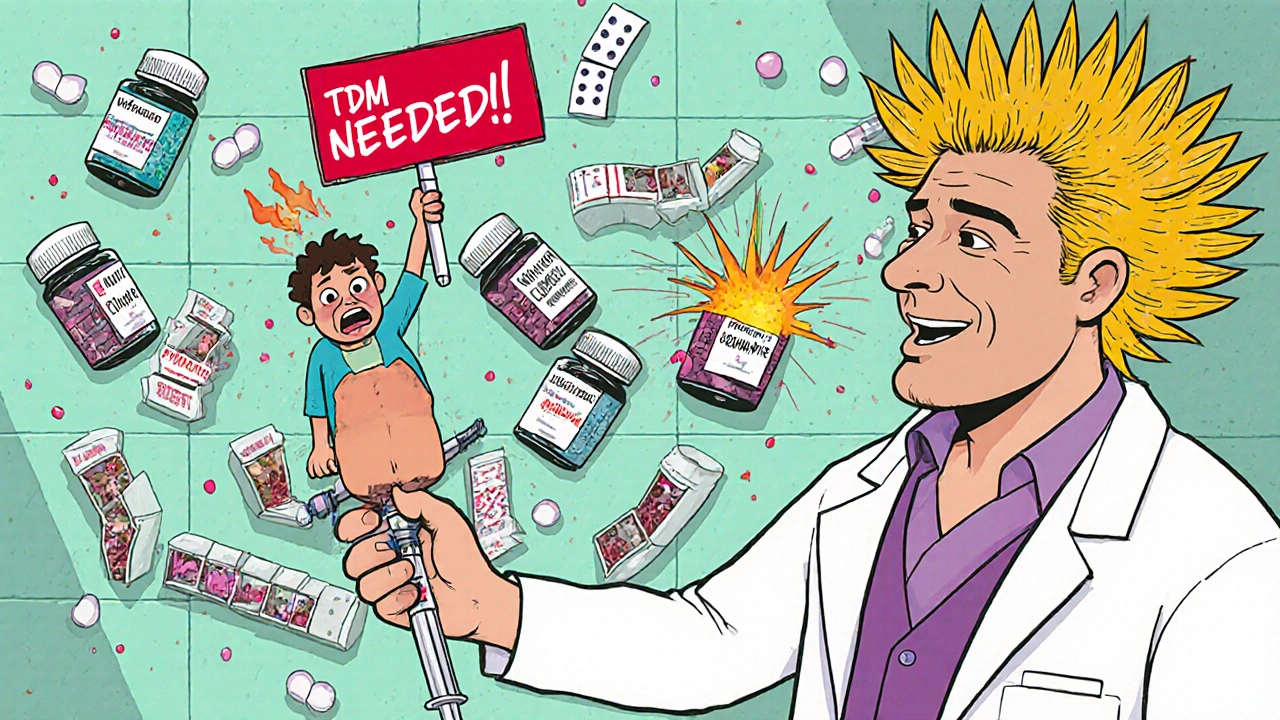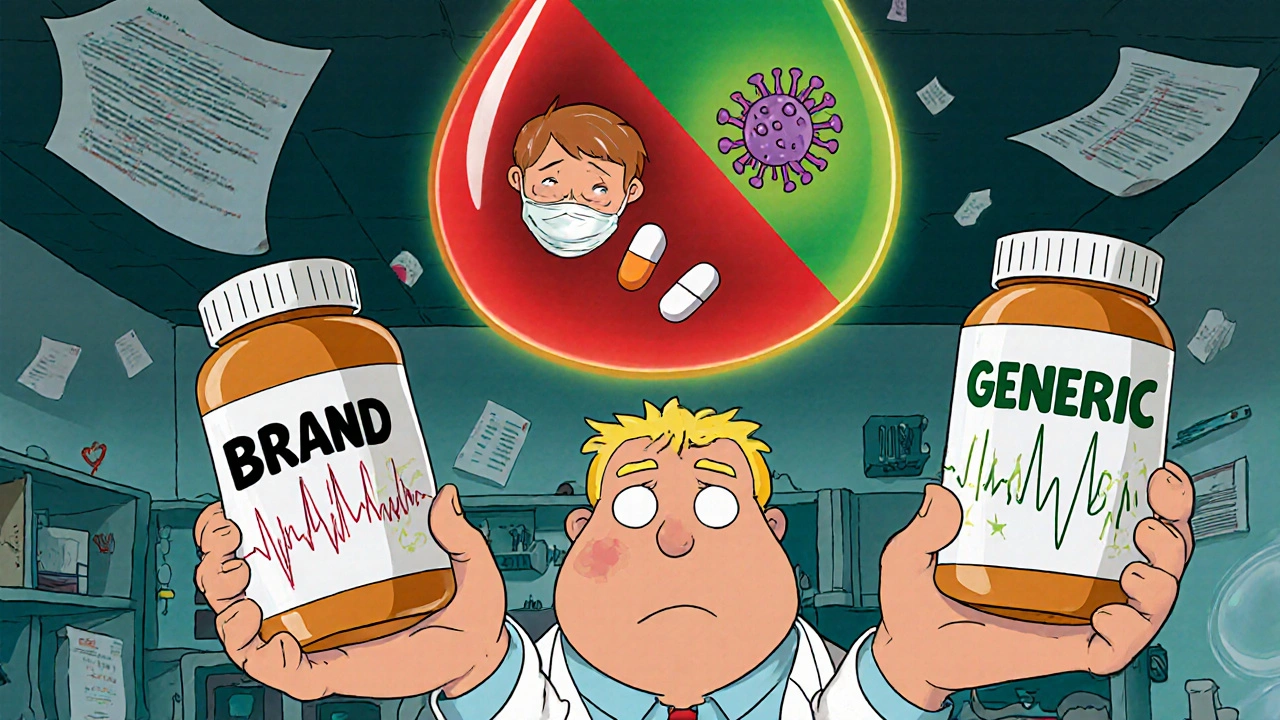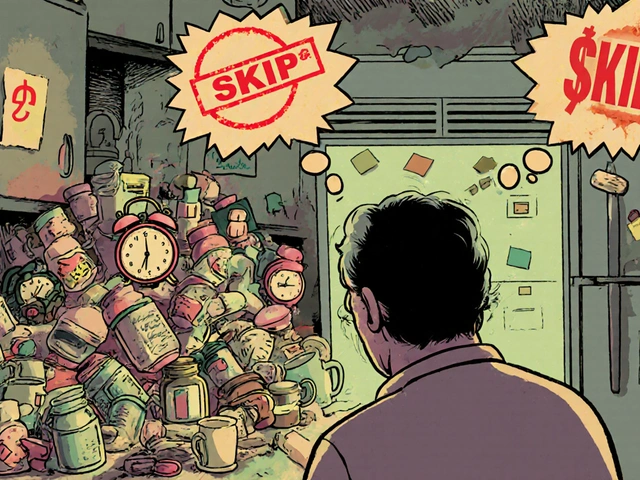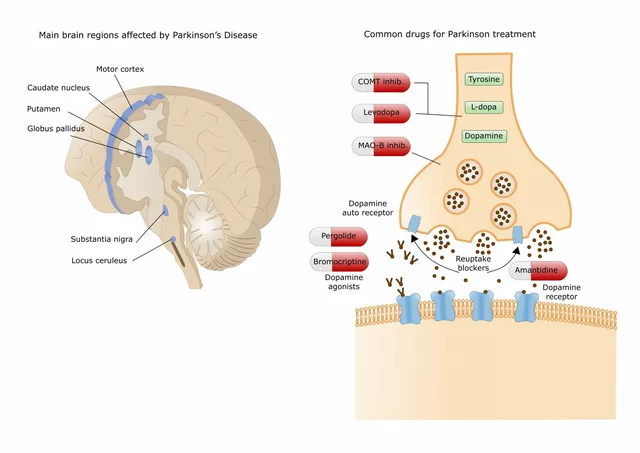When a patient switches from a brand-name drug to a generic version, most people assume it’s just a cost-saving swap with the same effect. But for drugs with a narrow therapeutic index - known as NTIs - that assumption can be dangerous. These are medicines where the difference between a therapeutic dose and a toxic one is tiny. Even small changes in how the body absorbs or processes the drug can lead to treatment failure, serious side effects, or even death. This is especially true for generic versions of NTIs, where bioequivalence standards don’t always capture real-world variability in patient response.
What Makes a Drug a Narrow Therapeutic Index (NTI) Drug?
NTI drugs have a very small window between the dose that works and the dose that harms. A slight increase can cause toxicity; a slight drop can mean the drug stops working. Common examples include warfarin, levothyroxine, phenytoin, and certain antiretrovirals like efavirenz and lopinavir/ritonavir. These aren’t just any medications - they’re the kind you take for life, where stability matters more than convenience.
The FDA defines NTI drugs as those with a therapeutic index of less than 2. That means the toxic dose is less than twice the effective dose. For comparison, most antibiotics have a therapeutic index of 10 or higher. With NTIs, even a 10% variation in blood levels can shift a patient from safe to unsafe. Generic manufacturers are required to prove their product is bioequivalent to the brand - meaning the average blood concentration is within 80-125% of the original. But averages don’t tell the whole story. Some patients absorb generics at the lower end of that range. Others absorb them too well. And when you’re dealing with a drug where the margin of error is razor-thin, those extremes matter.
Why Generic NTIs Need Extra Oversight
Generic drugs are cheaper, and that’s good. But cost savings shouldn’t come at the cost of safety. Studies show that when patients switch from brand to generic NTIs, up to 15% experience clinically significant changes in drug levels. In one 2021 analysis of patients on generic phenytoin, 12% had seizures after the switch - not because they stopped taking it, but because their blood levels dropped below the effective threshold. Another study on generic warfarin found that patients required dose adjustments in 23% of cases within the first month after switching.
The problem isn’t that generics are unsafe. It’s that the current approval process doesn’t account for individual variability. A generic drug might be bioequivalent on average across 24 healthy volunteers. But real patients have different liver enzymes, gut bacteria, kidney function, and even diet. A patient with Crohn’s disease might absorb a generic version poorly. An elderly person on multiple medications might metabolize it too slowly. These differences are invisible in the lab - but they show up in the clinic.
Therapeutic Drug Monitoring (TDM): The Safety Net
Therapeutic Drug Monitoring (TDM) is the process of measuring the actual concentration of a drug in a patient’s blood to ensure it’s within the safe and effective range. It’s not new - it’s been used for decades with drugs like digoxin and vancomycin. But for NTIs, especially generics, TDM is becoming essential.
TDM works by taking a blood sample - usually just before the next dose (trough level) - and sending it to a specialized lab. The lab uses high-precision methods to measure how much drug is circulating. If the level is too low, the dose is increased. If it’s too high, it’s reduced. This isn’t guesswork. It’s data-driven adjustment.
For example, a patient on generic lopinavir/ritonavir - an NTI antiretroviral - might switch from brand to generic without issue. But if they develop diarrhea from a new antibiotic, their absorption drops. Their viral load starts to rise. Without TDM, the doctor might assume non-adherence. With TDM, they see the drug level is half what it should be. They adjust the dose, and the viral load drops again. No one gets sick. No resistance develops.

Who Benefits Most from TDM?
TDM isn’t for everyone. It’s targeted. The patients who need it most are those on NTIs who:
- Have recently switched from brand to generic
- Have kidney or liver disease
- Are taking multiple medications that interact with the NTI
- Are elderly or underweight
- Have gastrointestinal disorders like IBD or celiac disease
- Are pregnant or children
- Have had prior treatment failure or toxicity
In New Zealand, where public drug funding encourages generic substitution, TDM is being quietly adopted in hospital clinics for high-risk patients. One Wellington-based HIV clinic started routine TDM for patients on generic dolutegravir after two cases of unexplained treatment failure. Within six months, they identified three patients with subtherapeutic levels - all had switched to a new generic batch. Adjusting doses brought their viral loads back to undetectable. No one was hospitalized.
The Challenges: Cost, Access, and Timing
TDM isn’t perfect. The biggest barrier? Access. In most countries, TDM isn’t covered by insurance unless it’s for specific drugs like vancomycin or cyclosporine. For NTIs, it’s often seen as experimental. In the UK, a single TDM test costs £250-£350. In the U.S., private labs charge $450-$650. Public health systems may take 10-14 days to return results - too long when a patient’s condition is deteriorating.
Another issue is interpretation. Not every doctor knows how to read a TDM result. A low level doesn’t always mean underdosing. It could mean faster metabolism due to smoking, or interactions with St. John’s wort. A high level might be due to poor clearance from kidney disease, not overdose. Without proper training, TDM can lead to wrong decisions.
And then there’s the timing. TDM requires planning. You can’t just order it on a whim. Blood must be drawn at the right time. Results take days. In emergencies, it’s not fast enough. That’s why TDM is best used proactively - not reactively. Check levels before switching generics. Check them again 4-6 weeks after the switch. Then, if the patient stays stable, you can space out testing.

What’s the Alternative?
Some argue we don’t need TDM - just use viral load or INR tests instead. But those are downstream indicators. If a patient’s viral load rises, the virus has already started replicating. If their INR spikes, they’re already at risk of bleeding. TDM catches problems before they happen. It’s prevention, not reaction.
For NTIs, monitoring drug levels is like checking the fuel gauge before your car runs out of gas - not after it stalls on the highway.
The Future: TDM as Standard Care for Generic NTIs
There’s growing momentum. The European AIDS Clinical Society now recommends TDM for certain antiretrovirals when switching generics. Canada’s McGill University Health Centre offers it routinely for complex HIV cases. South Africa’s pilot programs using TDM with generic antiretrovirals reduced treatment failure by 22% in just one year.
Technology is catching up too. New point-of-care devices are being tested that could give TDM results in hours, not days. Some labs now offer expedited testing for urgent cases. And as more data emerges, insurers may start covering it - especially when the alternative is hospitalization.
For now, the message is clear: if you’re prescribing or taking a generic NTI drug, don’t assume it’s the same. Ask your doctor: Should we check my drug levels after this switch? It’s not about distrust in generics. It’s about protecting people from preventable harm.
What are NTI drugs and why are they risky with generics?
NTI drugs, or narrow therapeutic index drugs, have a very small margin between the dose that works and the dose that causes harm. Examples include warfarin, phenytoin, and some antiretrovirals. Generic versions must meet bioequivalence standards, but those standards are based on average absorption across healthy people. Real patients vary - due to age, liver/kidney function, or other drugs - and those differences can push drug levels outside the safe range. That’s why switching to a generic NTI can sometimes cause toxicity or treatment failure, even if the generic is "approved."
Is therapeutic drug monitoring (TDM) only for HIV drugs?
No. TDM has been used for decades with drugs like digoxin, vancomycin, and cyclosporine. It’s also recommended for anticonvulsants like phenytoin, mood stabilizers like lithium, and immunosuppressants like tacrolimus. In HIV care, TDM is used for protease inhibitors and some NNRTIs - but not for NRTIs, because those drugs work inside cells and can’t be accurately measured in blood. The key is whether the drug has a narrow therapeutic index and measurable blood levels that correlate with effect.
How often should TDM be done after switching to a generic NTI?
For most patients, TDM should be done 4-6 weeks after switching to a new generic version. This gives the body time to adjust. If levels are stable and the patient is doing well, testing can be spaced out to every 6-12 months - or only if symptoms change. If levels are borderline or the patient has risk factors like kidney disease, testing may be needed more frequently. The goal is to catch problems early, not to test endlessly.
Can TDM replace regular lab tests like viral load or INR?
No. TDM measures drug levels; viral load measures how well the virus is controlled; INR measures blood clotting. They answer different questions. TDM helps prevent problems before they happen - for example, by catching low drug levels before the virus rebounds. Viral load and INR tell you something has already gone wrong. The best approach is to use TDM alongside these tests, not instead of them.
Is TDM covered by insurance?
Coverage varies. In many countries, TDM is covered only for specific drugs like vancomycin or cyclosporine. For NTIs like phenytoin or antiretrovirals, coverage is often limited to hospital-based or specialty clinic settings. Some private insurers will pay if there’s documented evidence of instability or prior treatment failure. Patients should check with their provider and ask if the test is considered medically necessary. In public systems, it’s often available only for high-risk cases.
What should I ask my doctor if I’m switching to a generic NTI?
Ask: "Is this drug a narrow therapeutic index medication?" Then ask: "Should we check my blood levels after I switch?" Also ask: "What signs should I watch for if the generic isn’t working the same?" And finally: "Is TDM available here, and how long does it take to get results?" These questions help ensure you’re not left guessing whether the switch is safe.
Final Thought: Safety Over Convenience
Generic drugs are a vital part of affordable healthcare. But when it comes to NTIs, convenience shouldn’t override caution. TDM isn’t a luxury - it’s a tool to make generic substitution safer. It doesn’t mean generics are bad. It means we need to treat them with more care.
For patients on these drugs, the goal isn’t just to stay alive. It’s to stay well. And sometimes, that means checking a number in a blood test - not just hoping the pill in the bottle is the same as the one before.




Brian Bell
November 14, 2025 AT 05:00Bro, I switched my generic warfarin last month and barely noticed a difference… until I started bleeding out of my nose at 3am. TDM saved my life. Now I get tested every 6 weeks. Worth every penny. 🙌
Nathan Hsu
November 14, 2025 AT 11:48Let me tell you, in India, we don’t even have access to TDM for NTIs-most patients just take whatever generic is cheapest, and pray. I’ve seen elderly patients on phenytoin go from seizure-free to status epilepticus after a switch. No monitoring. No follow-up. Just… hope. This isn’t healthcare. It’s roulette.
Ashley Durance
November 15, 2025 AT 00:54Actually, the data is misleading. Most studies on generic NTI switching are underpowered. The 15% adverse event rate? That’s from a single-center retrospective. Real-world data from Medicare shows only 2.3% of patients have clinically significant changes. Also, TDM is expensive and unreliable-labs vary by ±15% in results. You’re trading one risk for another.
Scott Saleska
November 16, 2025 AT 05:01Hey, I’m a pharmacist and I’ve seen this firsthand. A patient on generic levothyroxine came in with TSH at 48. She’d switched brands twice in 8 months. No one checked levels. She was told to ‘just take it more consistently.’ Her husband had to carry her to the ER. TDM isn’t optional-it’s mandatory for NTIs. Why is this even a debate?
Ryan Anderson
November 17, 2025 AT 09:42This is why we need policy change. 🇺🇸 TDM should be standard for all NTI generics-period. We don’t let people drive without seatbelts. Why are we letting them take life-critical meds without monitoring? I’ve sent letters to my reps. If you’re reading this, do the same. #TDMforNTIs
Eleanora Keene
November 18, 2025 AT 01:43I just want to say-this post made me feel seen. I’ve been on generic lopinavir for 2 years and my doctor never mentioned TDM. I felt guilty for having side effects, like I wasn’t trying hard enough. Turns out my levels were half what they should’ve been. Thank you for giving me the words to ask for help. You’re not alone.
Joe Goodrow
November 20, 2025 AT 00:27USA spends too much on healthcare because people want fancy blood tests instead of just taking their pills like they’re supposed to. Other countries get by just fine. Stop over-medicalizing everything. Just take the generic. Stop whining.
Don Ablett
November 21, 2025 AT 08:58The regulatory gap in bioequivalence standards for NTIs is well documented in the Canadian Journal of Clinical Pharmacology 2020. The 80-125% confidence interval is statistically valid for average bioavailability but fails to account for intra-individual variability. TDM remains the only clinically actionable safeguard. Unfortunately, funding models do not align with preventive care incentives.
Kevin Wagner
November 22, 2025 AT 12:06Y’all are acting like this is some new revelation. Nah. This is the same story as the 90s with cyclosporine-doctors ignored TDM, patients died, then the lawsuits came. Now it’s standard. Same thing’s gonna happen with NTI generics. The system always catches up… just after too many people get hurt. Let’s not wait for the headlines.
gent wood
November 22, 2025 AT 23:13I work in a London clinic. We started routine TDM for patients on generic phenytoin after three admissions in six months. One woman had a stroke because her levels dropped after switching to a cheaper batch. We now test everyone at switch, and again at six weeks. It’s not expensive-it’s essential. And it saves money in the long run. The NHS is slow, but it’s learning.
Dilip Patel
November 24, 2025 AT 03:15Why u so worried abt generics? In India we use them all day and no problem. U americans overthink everything. Just take the pill. Stop wasting money on blood tests. Pharma companies want u to pay more. Fake science.
Jane Johnson
November 25, 2025 AT 21:58There is no evidence that TDM improves outcomes in NTI generics. The studies are observational. Confounding variables. Selection bias. You are advocating for a procedure with unproven benefit. This is medical overreach.
Peter Aultman
November 27, 2025 AT 01:29My grandma switched to generic warfarin and started bruising like a grape. We got her TDM done-turns out her levels were sky-high. She’s fine now. No drama. Just a simple blood test. Why is this even controversial? It’s like checking your tire pressure before a road trip.
Barry Sanders
November 27, 2025 AT 11:41Oh please. TDM? You’re telling me we need to test blood levels for every single generic pill? Next you’ll want to monitor the air in their lungs. This isn’t science-it’s fearmongering. Let people take the cheaper pill. If they die, it’s their fault for not reading the label.